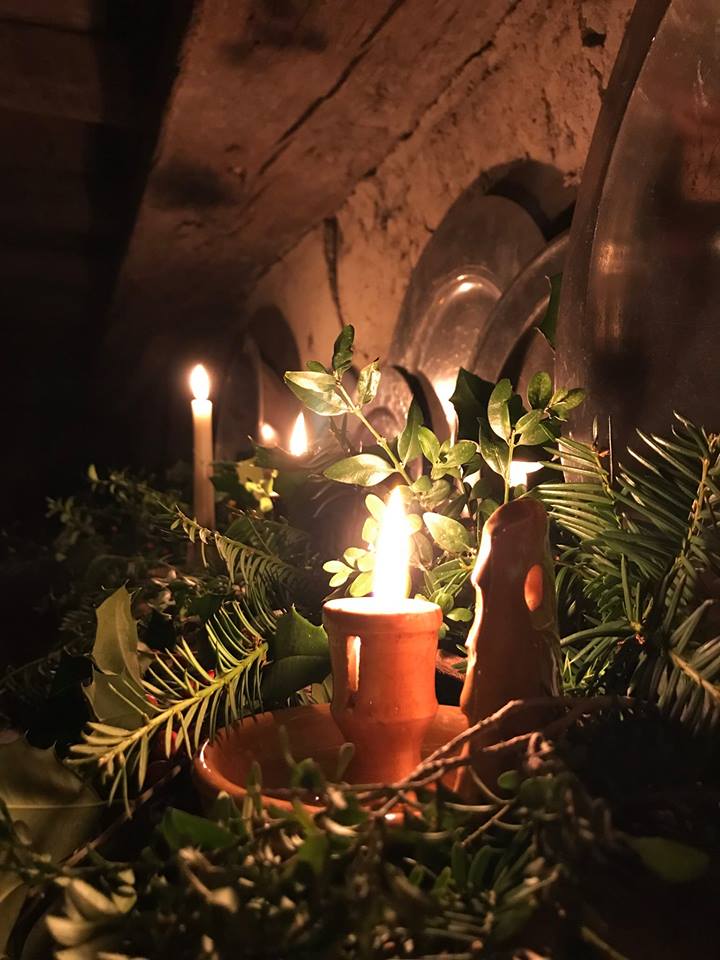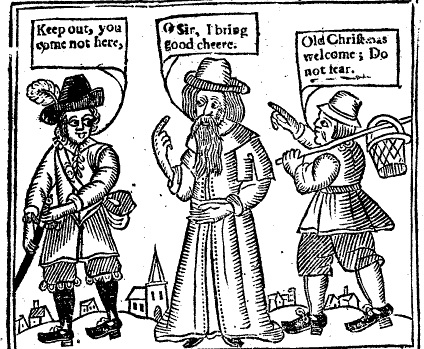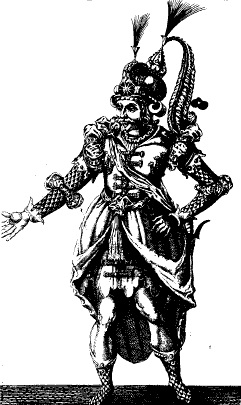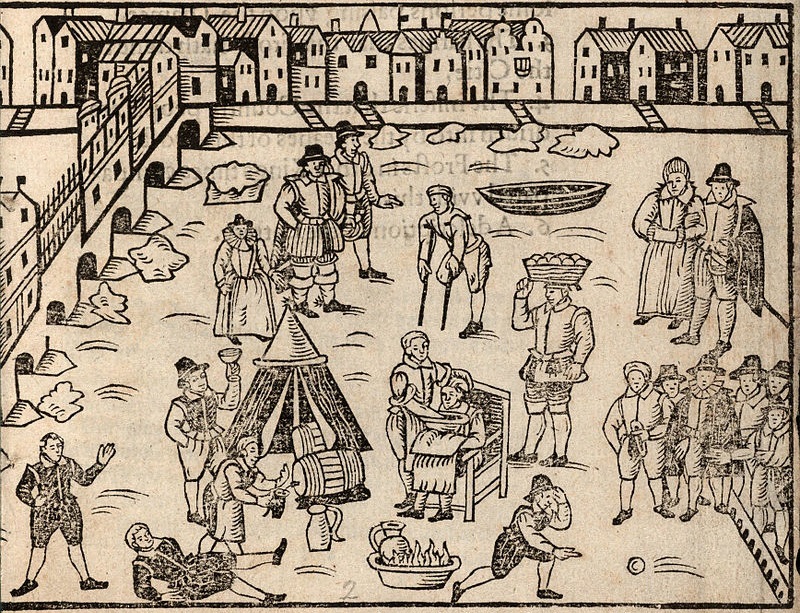The winter holidays are a happy time for many, and have been for centuries. In Anglo-Saxon England and Viking Scandinavia, people would wait out the long, dark winters in great halls, feasting, telling stories, and singing songs. The ancient Romans took it upon themselves to brighten up the season with the lively and whimsical Saturnalia. The Elizabethans, being connoisseurs of cheer and merriment, were no different and made Christmas one of their most extravagant celebrations of the year, ranging from Christmas Eve all the way up through Epiphany to make the famed Twelve Days of Christmas.
The centerpiece of Elizabethan Christmas festivities was the entertainment. Plays were frequently performed at court, and Shakespeare debuted both Love’s Labors Lost and King Lear at the Christmas festivities of Queen Elizabeth I[1] and King James I and VI[2] respectively (Ironically, Twelfth Night’s first recorded performance was in February). Although viewing plays was a popular enough pastime, members of the court frequently performed themselves, putting on “masques” for their own amusement and the enjoyment of their peers (and, most importantly, their superiors).[3] Such pageants tended to be steeped in allegory, stressing some political or moral point and casting their players not as the multifaceted characters literary scholars have spent the last few centuries analyzing from plays, but more often as broad archetypes or well-known mythological figures.[4] Masques often included musical interludes and sung narration, but music was performed by itself as part of Christmas festivities as well.[5] In an amusing quirk of tradition, one group that dominated the festivities at court in Elizabeth’s day were the gentlemen of Gray’s Inn, one of the Inns of Court. That is to say, the stars of Christmas in London were the lawyers, who would select a “Prince of Purpoole,” their particular name for a Lord of Misrule, to serve as a sort of master of ceremonies.[6]
Beyond performances at court, Christmas amusements could include more interactive pursuits. The famously lively Henry VIII, Elizabeth’s father, had a small forest planted at Greenwich in order to go hunting at Christmastime, for one thing,[7] and foot combats were seen well into the Elizabethan period.[8] Rich and poor alike enjoyed playing at cards and dice during the festivities,[9] and the Christmas celebration was an excellent time to socialized, serving as the venue for political discourse,[10] pleasant conversation,[11] and dancing.[12] Especially at court, whether the Queen’s or the local lord’s, Christmas was an occasion to see and be seen, particularly for young people hoping to catch the eye of a potential match or patron.[13]
It is a common belief that the more staunchly protestant elements at the Tudor court, those who would come to be known as Puritans, loathed such Christmas merriment. This is a reasonable assumption to make, considering the famous crackdown on holiday festivities during the Interregnum of the mid-seventeenth century.[14] In the sixteenth century, however, hardline English Protestants were more preoccupied with combatting Roman Catholicism than fellow Protestants, and they seem to have embraced Christmas revels as a means of secularizing a religious holiday they found no basis for in scripture. The Calvinist-leaning Cambridge, for instance, is known to have hosted multiple Christmas pageants and parties, often featuring a Lord of Misrule dressed up as a Catholic priest for the purpose of mockery.[15] Lest this be written off as youthful antics overriding Protestant sensibilities, it is worth noting that Thomas Cromwell himself, the architect of the English Reformation, was the one funding these parties.[16] Another notable example was the extravagant drunken revel held at Cheapside Cross in London in 1551, presided over by George Ferrers, the staunchly Protestant Edward VI’s Lord of Misrule, and which featured derisive pantomimes of the mass.[17]
The entertainment was certainly a major part of any Elizabethan Christmas, but then, as now, Christmas meant good food. For the common sort, Christmas treats could include plum puddings, mince pies, and roast beef,[18] all served up with hardy portions of ale, cider, or wine.[19] As for the gentry and aristocracy, their feasts were as extravagant as their entertainment, with the price of food and drink for a knight and his guests typically exceeding £100, which would translate to nearly $26,000 today.[20] In fairness, this cost did not cover a single dinner for a gentleman, his family, and a few close friends. Rather, this was the price of provisions for the whole Twelve Days of Christmas, meant to feed dozens of guests as a means of demonstrating wealth, largesse, and hospitality. The expectations of the aristocracy were even greater, with peers of the realm being obliged by tradition to keep their doors open to any gentlemen wishing to join them for the holiday.[21]
In addition to hosting holiday feasts for well-to-do guests, aristocrats and gentry traditionally used Christmas as a time to demonstrate their charity, bestowing gifts and alms on their needier neighbors.[22] This association between Christmas and charity ran deep in English culture, even after the Reformation had removed the salvific dimension of almsgiving,[23] that Elizabeth used the occasion in 1596 to issue a formal proclamation encouraging a widespread campaign of charity throughout her kingdom.[24]
For all the lively feasting and merriment that took place at Christmas in the Elizabethan period, the holiday did maintain a religious dimension. Indeed, although the English Reformation had streamlined the liturgical calendar by removing many saints’ feast days, Christmas made it through largely unscathed.[25] Christmas became a particularly popular time for the English to receive Communion.[26] Furthermore, a few decades after the Elizabethan age, when Oliver Cromwell’s regime was cracking down on Christmas celebrations, those writing in favor of the traditional festivities would argue that public feasting and celebration in observance of Christ’s birth was, itself, a pious act.[27]
By the nature of Elizabethan society, public celebrations of Christmas were decidedly Protestant, but it cannot be said that England was home only to Protestants, nor was it only Protestants who enjoyed winter festivities. Roman Catholics living in England at the time were among the more prolific Christmas hosts,[28] seeing charity and hospitality not just as Christian virtues but as necessities for salvation.[29] In an effort to keep their traditional religion alive in the face of Protestant reforms, however, English Catholics made Christmas carols, with liturgical Latin interludes and particular attention paid to Mary, a centerpiece of their own celebrations.[30] Furthermore, although they celebrated Christmas publicly to maintain the appearance of conversion, there is some evidence that English Jews were celebrating Hanukkah in secret during Elizabeth’s reign.[31]
Winter can, undoubtedly, be a dreary time, and this has been true for a great deal of human history, and so it is natural that people gather together for warmth and cheer to drive away the cold. For the Elizabethans, this meant great spectacles and diversions, this meant good food and good company, and this meant reaching out to share the year’s bounty with friends and neighbors. In this, the season of long nights and warm hearths, we here at GSM-Bristol wish you all a very merry suite of winter holidays!
[1] William Shakespeare, A Pleasant Conceited Comedy Called Loves Labors Lost, as it Was Presented Before Her Highnes this Last Christmas (London: W.W. 1598), 1.
[2] William Shakespeare, True Chronicle History of the Life and Death of King Lear, and His Three Daughters, With the Unfortunate Life of Edgar, Sonne and Heire to the Earle of Glocester, and his Sullen and Assumed Humour of Tom of Bedlam, as it Was Plaid Before the Kings Majesty at White-Hall, uppon S. Stephens Night, in Christmas Hollidaies (London: Nathaniel Butter, 1608), 1.
[3] Katherine Butler, “The Royal Household and Its Revels” in Music in Elizabethan Court Politics (Suffolk, UK: Boydell Press, 2015), 92.
[4] Ibid, 96.
[5] W.R. Streitberger, “The Yeomen of the Revels, 1534-1543,” in Court Revels 1485-1559 (Toronto, ON: University of Toronto Press, 1994), 145.
[6] Butler, “The Royal Household and Its Revels,” 84.
[7] Streitberger, “The Yeomen of the Revels, 1534-1543,” 143.
[8] Ivan L. Schulze, “Elizabethan Chivalry and the Faerie Queene’s Annual Feast,” Modern Language Notes 50, no. 3 (March 1935): 161.
[9] Phebe Jensen, “’Honest Mirth & Merriment’: Christmas and Catholicism in Early Modern England,” in Redrawing the Map of Early Modern English Catholicism, ed. Lowell Gallagher (Toronto, ON: University of Toronto Press, 2012), 215.
[10] Butler, “The Royal Household and Its Revels,” 96.
[11] The Vindication of Christmas, (London: G. Horton, 1653), 8.
[12] Ibid.
[13] Butler, “The Royal Household and Its Revels,” 96.
[14] Jensen, “‘Honest mirth & merriment’: Christmas and Catholicism in Early Modern England,” 216.
[15] Robert Hornback, “’Sports and Follies Against the Pope’: Tudor Evangelical Lords of Misrule,” in The English Clown Tradition from the Middle Ages to Shakespeare (Suffolk, UK: D.S. Brewer, 2009), 70-71.
[16] Ibid, 70.
[17] Ibid, 86-87.
[18] The Vindication of Christmas, 4. Jensen, “‘Honest mirth & merriment’: Christmas and Catholicism in Early Modern England,” 215.
[19] Ibid, 7.
[20] Lawrence Stone, “The Anatomy of the Elizabethan Aristocracy,” The Economic History Review 18, no. 1/2 (1948): 7.
[21] Ibid.
[22] Steve Hindle, “Dearth, Fasting and Alms: The Campaign for General Hospitality in Late Elizabethan England,” Past & Present 172 (August 2001): 45.
[23] Carlos M.N. Eire, Reformations: The Early Modern World, 1450-1650 (New Haven, CT: Yale University Press, 2016), 707.
[24] Hindle, “Dearth, Fasting and Alms: The Campaign for General Hospitality in Late Elizabethan England,” 44.
[25] Jensen, “‘Honest mirth & merriment’: Christmas and Catholicism in Early Modern England,” 214-215.
[26] Haigh, “The Taming of Reformation: Preachers, Pastors and Parishioners in Elizabethan and EarlyStuart England,” History 85, no. 280 (October 2000): 587.
[27] The Vindication of Christmas, 3.
[28] Jensen, “‘Honest mirth & merriment’: Christmas and Catholicism in Early Modern England,” 223.
[29] Ibid 230.
[30] Ibid, 220.
[31] Philippa Bernard, “Roderigo Lopez: Physician to the Queen,” European Judaism: A Journal for the New Europe 15, no. 2 (Winter 1981): 5.








